#Chinese Languages
Text
okay so @unfortunatebedhead got us more of these wild-ass corn chip snack things that have these incomprehensible comics on the back and I texted my dad to ask what it said and he's all "sorry toch i can't speak cantonese" but last time we got 'em unfortunatebedhead's mom said it was incomprehensible in cantonese as well so help:
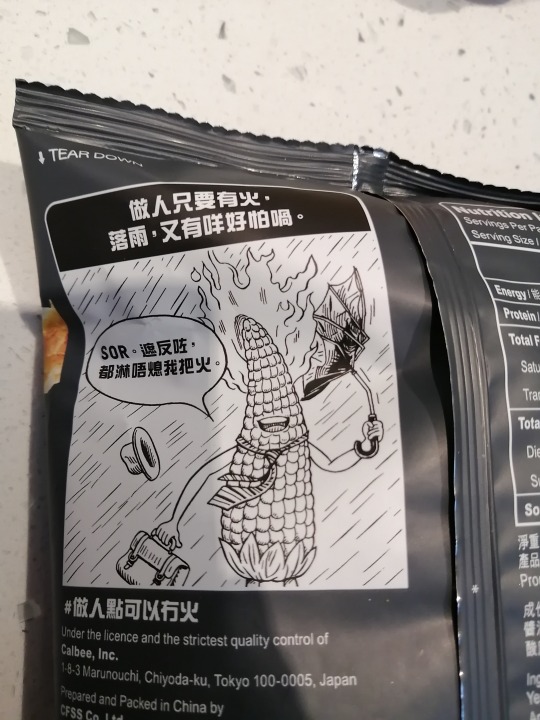
the fuck does this mean????
483 notes
·
View notes
Text
saying "plural system" feels like speaking Chinese, which extensively overuses combining two words of the same or adjacent meanings to avoid confusion with the other meanings of either isolated word
#plural system#plural#system#language#languages#chinese#chinese language#chinese languages#mandarin#漢語#中文#汉语
4 notes
·
View notes
Note
Hi! Do you understand/speak Chinese?
Hi Anon!
I don't speak or understand any Chinese. Although after watching a bunch of Chinese shows this spring I figured out how to count to three (yī, èr, sān; 一二三). And while watching The Lost Tomb: The Ultimate Note I began to recognize the word for secret; it sounds like mi-mi. (I just checked on the Pleco app, which gives the Pinyin as mìmì and the characters as 秘密). I also started to recognize a couple of common phrases at the time, but I no longer remember what any of them were.
So that's the extent of my knowledge. Sorry if you were hoping for help on something! Or if not, I'm happy to satisfy your curiosity :-)
If you are looking for language resources someone on here recommended the Pleco app and I found it useful for looking up words and phrases I heard/saw in shows. The app logo looks like this on my iPhone:
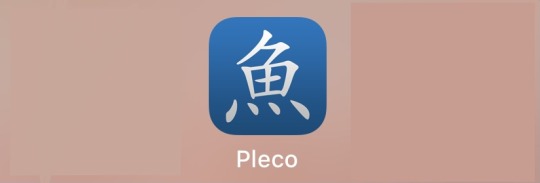
4 notes
·
View notes
Text
In light of Duolingo laying off its translators, here are my favourite language apps (primarily for Mandarin Chinese, Japanese, and te reo Māori).
Multiple Languages
Anki is a flashcard programme and app that's not exclusively for languages. While making your own decks is ideal, you can also download shared decks for most languages.
If you're learning Japanese, specifically, Seth Clydesdale has websites for practicing alongside Genki's 2nd or 3rd editions, and he also provides his own shared Anki decks for Genki.
And if you're learning te reo Māori, specifically, here's a guide on how to make your own deck.
TOFU Learn is an app for learning vocabulary that's very similar to Anki. However, it has particularly excellent shared decks for East Asian languages. I've used it extensively for practicing 汉字. Additionally, if you're learning te reo Māori, there's a shared deck of vocabulary from Māori Made Easy!
Mandarin Chinese
Hello Chinese is a fantastic app for people at the HSK 1-4 levels. While there's a paid version, the only thing paying unlocks is access to podcast lessons, which imo are not really necessary. Without paying you still have access to all the gamified lessons which are laid out much like Duolingo's lessons. However, unlike Duolingo, Hello Chinese actually teaches grammar directly, properly teaches 汉字, and includes native audio practice.
Japanese
Renshuu is a website and app for learning and practicing Japanese. The vast majority of its content is available for free. There's also a Discord community where you can practice alongside others.
Kanji Dojo is a free and open source app for learning and practicing the stroke order of kanji. You can learn progressively by JLPT level or by Japanese grades. There's also the option to learn and practice kana stroke order as well.
10K notes
·
View notes
Text
I want to post this here too because I’ve seen it happen a few times

Please understand that there are cultural differences and language differences, if you see this happening let the person clarify what they meant, that person might just not be familiar with words the western side of the internet use
#bearz rambling tag#no it’s not really possible to let everyone who uses this term to change#because as far as I know this is the most common word with use on Chinese websites#I didn’t know that pairing are called ‘ship’ here#like why would I even know that#‘ship’ makes zero sense to me#it took me a while to learn the fandom language people speak here#it’s hard#give people time#shipping culture is very different too#Like on Chinese site you HAVE to clarify the Top and the Bottom of this ship in the ship name#it is very very important to them#people who like the same ship but with different Top Bottom preference will fight till no end#imagine how confused I was when I first got here#where there’s no top bottom differences#it’s not really a smut thing#it’s more a dynamic thing#AxB and BxA is very different#oh I can talk so much about the differences on fandom cultures#if ya are interested in more please feel free to ask#it’s very interesting to me#I wanna talk about it
9K notes
·
View notes
Text
when you reblog, tell us what languages in the tags!!
#polls#for me it's english japanese korean italian spanish and german#remarkably there's no chinese that i can think of#i need to change that srsly#now i'm just running through languages and songs in my head to make sure i haven't missed any lmao#oh there's a swahili song i love and it WASN'T on my playlist BUT IT IS NOW#okay yeah I think that's everything#also if you saw this for a split second and then it disappeared no you didn't#i forgot to set time to a week oops
3K notes
·
View notes
Video
undefined
tumblr
28K notes
·
View notes
Text
火火火火火火火火火火火火火火火火
火炎炎炎炎炎炎炎炎炎炎炎炎炎炎火
火炎焱焱焱焱焱焱焱焱焱焱焱焱炎火
火炎焱燚燚燚燚燚燚燚燚燚燚焱炎火
火炎焱燚 this 燚焱炎火
火炎焱燚 is 燚焱炎火
火炎焱燚 fine 🐶 燚焱炎火
火炎焱燚燚燚燚燚燚燚燚燚燚焱炎火
火炎焱焱焱焱焱焱焱焱焱焱焱焱炎火
火炎炎炎炎炎炎炎炎炎炎炎炎炎炎火
火火火火火火火火火火火火火火火火
#meme#japanese language#Japanese#kanji#漢字#visual poetry#text#japanese text#this is fine#ascii art#chinese characters
2K notes
·
View notes
Text
10 movies I watched in Chinese class
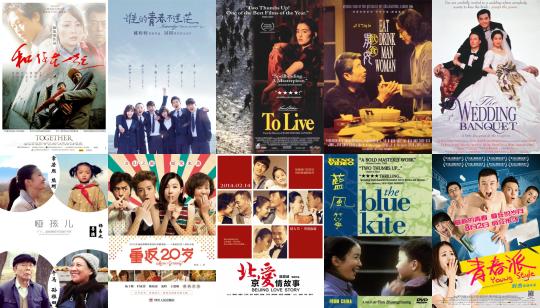
This post is the unofficial sequel to 10 iconic Mandopop songs from Chinese class. No one asked for it, but I watched to chronicle what I could remember before more fades from my memory! I saw these movies in Chinese class in high school and college, and I had to do some sleuthing to find some names.
The synopses are from IMDb, revised by me. I put links to watch for free on YouTube when I was able to find one, but they might not work in your country.
1. 《和你在一起》 Together (2002)
A violin prodigy and his father travel to Beijing, where the father seeks the means to his son's success while the son struggles to accept the path laid before him.
Watch on YouTube
2. 《谁的青春不迷茫》 Yesterday Once More (2016)
Lin Tianjiao, the top student in her class, is struggling to cope under intense academic pressure. After she is nearly caught cheating on a test, she befriends Gao Xiang, a free-spirited slacker.
Watch on YouTube
3. 《活着》 To Live (1994)
Based on the novel by Yu Hua, four generations of the once-wealthy Xu family experience the difficult changes of the Chinese Civil War, the Great Leap Forward, and the Cultural Revolution.
Watch on YouTube
4. 《喜宴》 The Wedding Banquet (1993)
To satisfy his parents, Gao Wai-Tung, a gay man in a fulfilling relationship with his partner Simon, marries his female tenant Wei-Wei. Things get out of hand when his parents come to visit.
5. 《饮食男女》 Eat Drink Man Woman (1994)
A widowed chef lives with his three grown daughters, who each experience ups and downs in their lives and romantic relationships as they leave the family home.
Watch on YouTube
6. 《哑孩儿》 Dumb Child* (2016)
After graduating from college, Fang Yan takes a job as a teacher in a rural area of China. There she meets a young girl named Yaya who doesn't attend school due to her hearing impairment.
Watch on YouTube
*Dumb as in mute. It's not a great English name...
7. 《重返20岁》 20 Once Again/Miss Granny (2015)
A 70-year old woman living unhappily with her son's family is magically transformed into her 20-year-old self. She befriends her grandson and decides to fulfill the dreams of her youth.
Watch on YouTube
8. 《北京爱情故事》 Beijing Love Story (2014)
Different generations look at love, romance, and commitment, all from a uniquely Beijing perspective. All 5 couples and stories are intertwined a la Love Actually.
9. 《蓝风筝》 The Blue Kite (1993)
The lives of a Beijing family throughout the 1950s and 1960s, as they experience the impact of the Hundred Flowers Campaign, the Great Leap Forward, and the Cultural Revolution.
Watch on YouTube
10. 《青春派》 Young Style (2013)
Struggling with romantic woes after his plan to confess to his crush goes awry, Ju Ran fails the college entrance exam (gaokao) and is forced to repeat his last year of high school.
Watch on YouTube
#my watchlist#chinese movies#taiwanese movies#chinese film#taiwanese film#chinese#mandarin#mandarin chinese#chinese language#studyblr#langblr#learning languages#language learning#chinese langblr#mandarin langblr#languageblr
419 notes
·
View notes
Text
Some Chinese fashion styles
Disclaimer: The following styles and their definitions were observed by me and are not authoritative. I am only familiar with Hanfu and if I made mistakes and picked the wrong photo examples or fraud shops, please let me know. Also, this post focused on women's fashion because 1. I am not into men's fashion so I don't know much about them. 2. The algorithm also knew that so I don't really see them.
汉服/Hànfú
传统服饰/Chuántǒng fúshì (传服/chuán fú)
清汉女/Qīng hàn nǚ
旗装/Qí zhuāng
旗袍/Qípáo
新国风/Xīn guó fēng、新中式/Xīn zhōngshì
汉元素/hàn yuánsù
茶艺服/Cháyì fú or 茶服/chá fú
唐装/Tángzhuāng
中山装/Zhōngshānzhuāng.
汉服/Hànfú
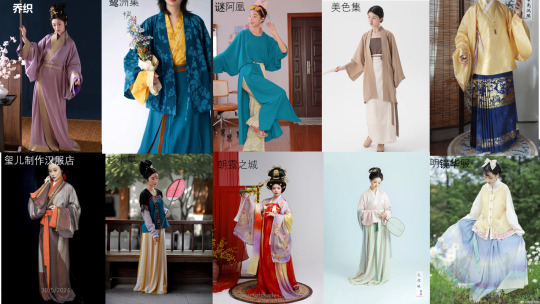
The ethnic clothing of Han Chinese (not the Han Dynasty).
There was a prohibition of Han clothing and hair styles in Qing dynasty, i.e. the 剃发易服/Tìfā yìfú qu Queue Ordinance, so modern hanfu is an on-going revivalist moment.
Modern hanfu are based on archeological evidences with minor twists to suit modern like, such as the type of fabric used and cut.
As a result, there are many types of garments and sub-styles. The figure above shows some examples.
While which style should be included and promoted is a constant debate, but in general, the cutout line is the Qing dynasty (however small accessories such as purses are alright).
传统服饰/Chuántǒng fúshì (传服/chuán fú)
No example because I am not sure who identified with this label.
The Chinese traditional clothing.
This either referred to historical clothing restorers (regardless of ethnicity) or people who promoted that the traditional clothing of Han people should be in the late Ming dynasty style, since "people should get up at where they had fallen".
They might be agreeable with the hanfu movement or not.
清汉女/Qīng hàn nǚ
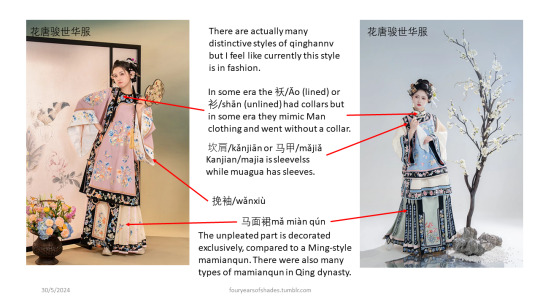
The clothing of women of Han Chinese in the Qing dynasty.
Since the Queue Ordinance wasn't that strictly enforced on Han women, the Han women clothing in the Qing dynasty had quickly absorbed Manchurian's elements while retaining the characteristic two-piece silhouette. (Manchurian women wore a one-piece robe.)
I believed it appeared around 2019 when the styles of hanfu had moved to fully embroidered surface to a more tone down brocade or weaved patterns.
旗装/Qí zhuāng

The ethnic clothing of Man people (Manchurian).
The women's clothing are generally in round collar opened on the left (youren) with straight sleeves.
The most basic item is a 衬衣/chènyī, which doesn't have vents.
However, the most common item I have seen on the street is a 氅衣/chǎng yī (probably rented), which should be worn on top of 衬衣, since they have side vents.
They usually have no standing-up collar but in some cases a fake collar could be worn.
On top of changyi they could wear a 马褂/mǎguà、坎肩/kǎnjiān、褂裥/guà jiǎn.
旗袍/Qípáo
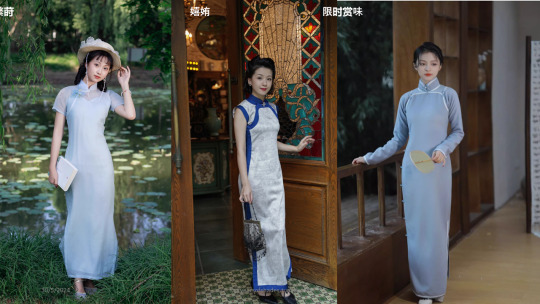
The Chinese clothing of women originated from the Minguo era, known in English as qipao or cheongsam.
The male equivalent is 长衫/chángshān.
Currently in style is the retro-cut, while uses the traditional flat cut (no shoulder seam) instead of the more body-hugging modern draping style.
There are also many variations and cuts, but the overall silhouette is similar.
新国风/Xīn guó fēng、新中式/xīn zhōngshì
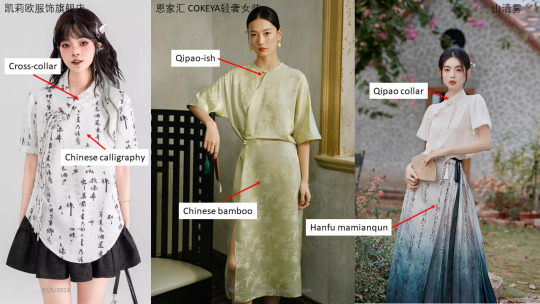
Innovative clothing that was inspired by Chinese traditional aesthetic.
It is an umbrella term.
汉元素/hàn yuánsù refers to clothing inspired by hanfu specifically, while xinguofeng could be inspired by qipao and other ethnic clothing. In addition, hanyuansu is a term more familair to hanfu-ers, so the target audience is slightly different between hanyuansu and xinguofeng.
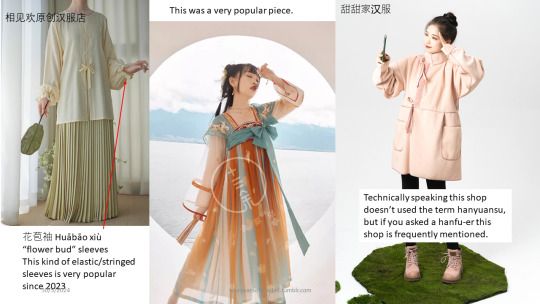
茶艺服/Cháyì fú or 茶服/chá fú,i.e tea dress, which aimed to convey a zen and rustic aesthetic could also be considered a sub-style. They are often worn by retirees, artists or workers in tea shops, calligraphy shops, Chinese spas, Chinese traditional medicine clinics etc.

The older "Chinese style" generally refers to 唐装/Tángzhuāng and 中山装/Zhōngshānzhuāng.
Tangzhuang (Tang Suit) was a men suit characterized with a mandarin collar with a row of 盘扣/pán kòu frogs in the middle. There are two pockets at the bottom front of the suit. It was a well-known looked worldwide due to the 2001 APEC summit. However, other clothes resembled a 马褂/mǎguà could also be called a tangzhuang.
Zhongshanzhuang was designed and named after Sun Yat-sen but was often known in English as the Mao Suit. Mao Suit was characterised with a 关门领/Guānmén lǐng(“closed-door collar", but also known as Mao collar in English) with a row of round buttons. There are four pockets at the front of the suit.
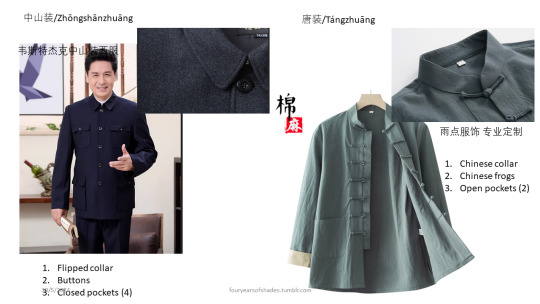
中华lolita/Zhōnghuá lolita
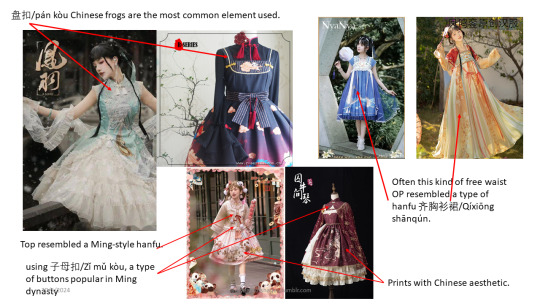
A sub-style of the lolita fashion inspired by cheongsam/qipao, hanfu or other Chinese artistic elements.
The same item could appeared in different styles, but with different cut and accessories. The following examples showed a mamianqun used in different styles.

THE END
#chinese fashion#hanfu#qinghannv#qipao#qizhuang#chinese language#non-hanfu#lolita fashion#terminology#i rarely seen men in alternate fashion#like i saw maybe one in the last year#they spent money elsewhere#like shoes#long post#reference#fouryearsofshades#i spent so much time on this post#hope you will like it#feel free to correct me if i am not right
539 notes
·
View notes
Text
Best online foreign language courses Nashik | I Pro-Edu
i-Pro Edu is a team of enthusiastic people who are passionate about their work. We help people to embed new skills for succeeding in their careers and profession.
The Institute operates across multiple verticals. Our different wings offer a bouquet of courses and services that cater to different needs.
Language Institute provides training in various Indian and Foreign Languages such as English, German, French, Japanese, Sanskrit, Marathi, and Hindi.
Commerce Academy offers professional coaching for various courses including XI-XII (commerce), BBA, BBA-IB, B. Com, M. Com, etc.
Study Abroad Consultancy wing provides end to end services for higher education abroad, including preparations for GRE/IELTS exams.
Joining a course at i-Pro Edu itself is an experience. We are a family of fun-loving teachers and amazingly diverse learners. We welcome you to join the family!
I Pro-Edu foreign language Classes in Nashik. This is the best foreign languages classes in Nashik.
MEET OUR TEAM
0 notes
Text
Look, I knew five languages by age 19 and now I am learning like 3 more. I work as a language instructor and a consultant. If I can give language learners only one advice, this is it.
STOP LEARNING WORDS ON THEIR OWN.
You're doing yourself a disservice by learning lists of "30 words you must know!" "100 most common words!" like it literally means nothing if you cannot use those words in an appropriate context with proper grammar. So what you actually need to do is learn those words via example sentences.
Of course, sentences have more words so you may think you're learning less but you're actually learning the way to use it in context. That's what's important.
Language is about communication, which also means if you want to learn languages, you have to observe how people communicate with each other universally. Native speakers never have a list of words they know and they don't count every single new word they've learned. So why are you doing it to yourself? What native speakers do is listen to the new word, remember the context they're spoken in, and keep using that word in that context. And that's why people go "wait, you can use that word LIKE THAT?" all the time. So you, a language learner, are also allowed to do that. I'm not even saying those word lists are useless but they're the most useful AFTER you've known most of them and are trying to go over them for practice etc. Native speakers do click on those word lists to check out how many words they don't know or to remind themselves of those words or to learn some facts about each word. That should be your goal as well.
Learn sentences. Learn them in context. Do not fall into the "I must know xx amount of words or I'm a failure at language learning" trap perpetuated by bloggers or youtubers or whatever. Have fun with it!
#language learning#studyblr#langblr#100 days of productivity#chinese studyblr#japanese studyblr#korean studyblr#how to learn#learning#academia#academic#academics#language study#language#languages#study tip#study#study motivation
671 notes
·
View notes
Text
Chinese is used as Official Languages at U.N. Headquarters.
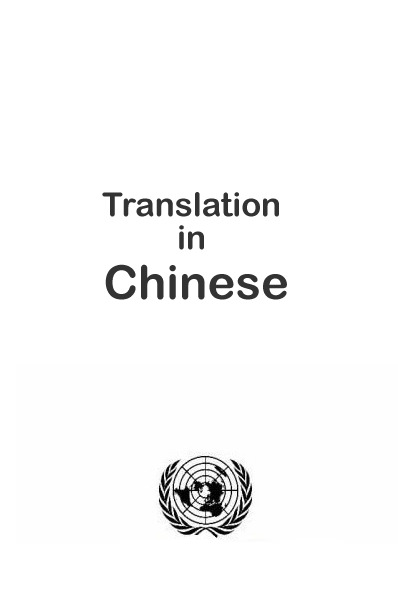
Chinese become :
Official language of the United Nations (except the International Court of Justice, ICJ) (1 Feb. 1946)
Official language of the Security Council (24 June 1946)
Working language of the General Assembly (18 Dec. 1973)
Working language of the Security Council (17 Jan. 1974)
Chinese is used as Official Languages at U.N. Headquarters.
On 24 June 1946, Security Council adopted its Provisional Rules of Procedure S/96, naming Chinese as official languages, and English and French as working languages.
On 18 December 1973, General Assembly resolution 3189 (XXVIII) included Chinese as a working language of the General Assembly and suggested the Security Council consider adding Chinese as a working language.
On 17 January 1974, Security Council resolution 345 (1974) decided to include Chinese as a working language of the Security Council.
#u.n. general assembly#U.N. Security Council#ECOSOC#DGACM#chinese#Chinese Languages#official languages#Chinese Précis-writers#Chinese Translators#chinese translation#Chinese Interpreters
0 notes
Text
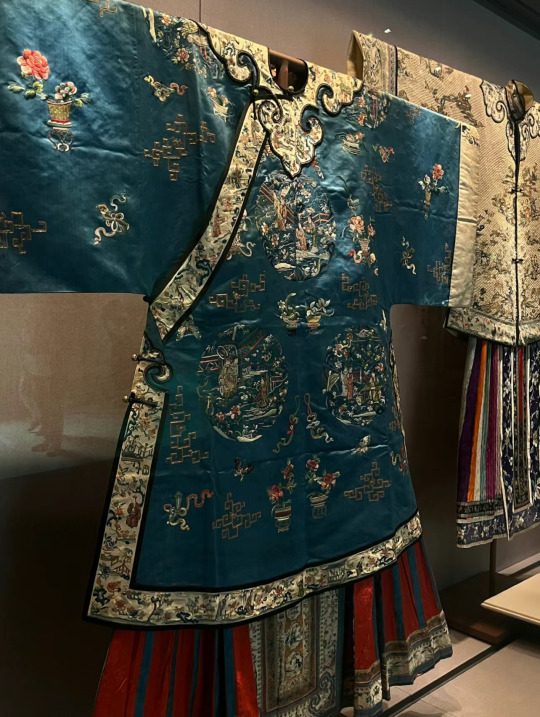
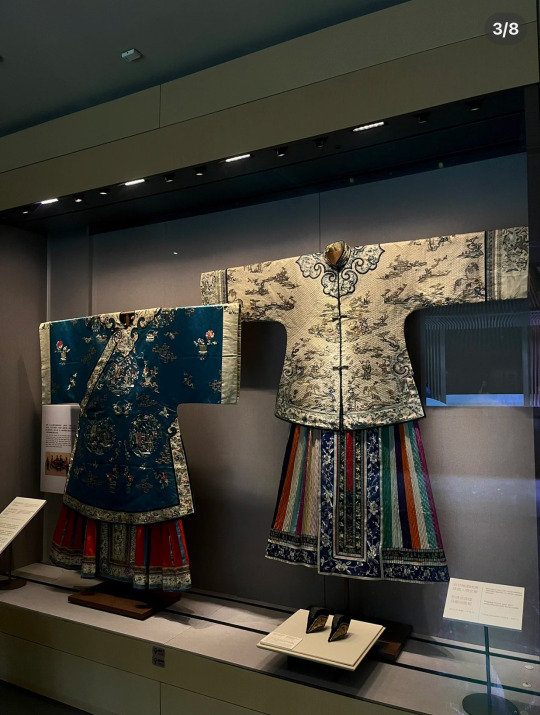
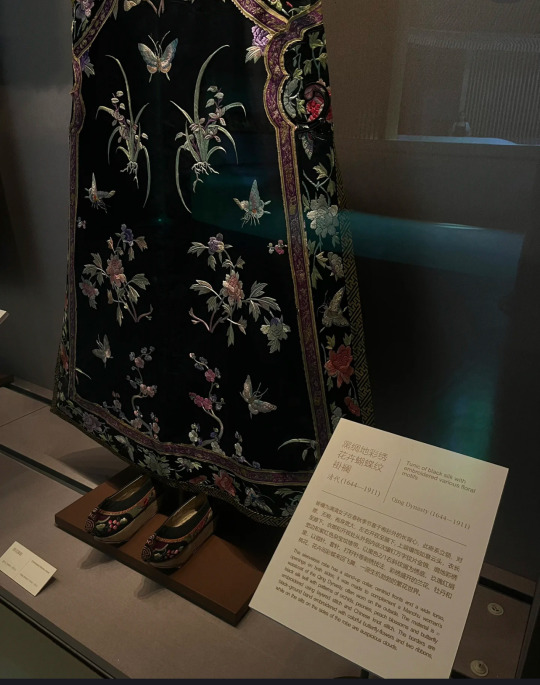
Qing Dynasty hanfu (1644-1912) Silk Museum of HangZhou (杭州丝调博物馆)
#china#chinese history#history#qing dynasty#education#language#archaeology#etymology#hangzhou#qing#artifacts#historical#historical clothing
531 notes
·
View notes
Text




ahmadezzrinloy Golfer in arms, Having @.carlossainz55 to watch my back! Nice try @.charles_leclerc 👊🏻🤣
+Bonus: back slaps

#they are soo....#carlos' love language is violence#aggressive affection i'll call it#they're really in 'don't take him from me' mode#carlos sainz#charles leclerc#charlos#Chinese GP '24#2024#gifs#mine#formula one#f1#ferrari#shanghai gp 2024
567 notes
·
View notes
Text
The scale of MXTX characters hand writing from Worst to Best
Hua Cheng: literally intelligible, those basically aren't even words any.
Wei wuxian: the equivalent of a sleep deprived adhd stem student notes right before an exam. Technically legible but only to him, people who know him really well.
Luo Binghe: it's good. Not outstanding but Nicely legible, pretty when it needs to be.
Shen Qingqiu: technically there's nothing wrong with his hand writing, but His writing is too modern for the Xianxia settings he's living in and although it's not too much of a problem it's definitely enough to make peoples eyebrow raise.
Xie Lian: stunningly beautiful calligraphy. Truly just art in written form.
Lan wangji: the most beautiful and technically perfect hand writing you have everything seen. Calligraphy teachers weap with joy when they see his writing.
#i dont know what this is#its just something that appeared in my mind#im not entirely sure how different modern Chinese handwriting would be from historical calligraphy#but based on my understanding of written language evolution as a rule i theres theres probably some noticable difference#which would trip up shen yuans modern ass#:P#mxtx characters#mxtx mdzs#mxtx#mxtx tgcf#mxtx svsss#hua cheng#wei wuxian#shen qingqiu#shen yuan#luo binghe#xie lian#lan wangji#scum villian self saving system#scum villain#mo dao zu shi#grand master of demonic cultivation#heaven official's blessing#tian guan ci fu#shit post
629 notes
·
View notes